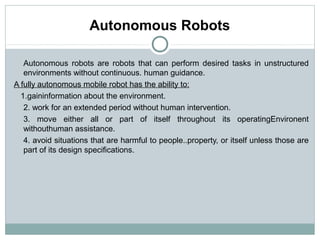
Mobile robot1
- 1. Autonomous Robots Autonomous robots are robots that can perform desired tasks in unstructured environments without continuous. human guidance. A fully autonomous mobile robot has the ability to: 1.gaininformation about the environment. 2. work for an extended period without human intervention. 3. move either all or part of itself throughout its operatingEnvironent withouthuman assistance. 4. avoid situations that are harmful to people..property, or itself unless those are part of its design specifications.
- 3. Locomotion At the lowest level is the locomotion capability of the robot's physical platform. Locomotion is the act of moving from place to place. Locomotion relies on the physical interaction between the vehicle and its environment. different types of locomotion are 1. Legged Locomotion 2. Snake Locomotion 3. Free-Floating Motion 4. Wheeled Locomotion
- 4. Sensory perception The next higher level is sensory perception. The robots have to sense what is in their environment in order to navigate in it, detect hazards, and identify goals such as exits and simulated victims.
- 5. Knowledge representation • The knowledge representation is the next level. • It encompasses the robot's ability to model the world, using both"a priori information (such as might be needed to recognize certain objects In an environment)andnewlyacquiredinformation (obtained through sensing the environment as it explores).
- 6. Planning The planning or behaviour generation elements of the robots build on the knowledge representation and the sensing elements. The robots must be able to navigate around obstacles, make progress in their mission (that is to explore as much as possible of the arenas and find simulated victims), take into account time as a limiting resource, and make time critical decisions and tradeoffs.
- 7. Autonomy The overall autonomy of the robot is the next element to be evaluated. The robots are designed to operate with humans. The level of interaction may vary significantly, depending on the robot's design and capabilities.
- 8. Collaboration The final element to be evaluated in the robot's overall capabilities is collaboration among teams of robots. Multiple robots should be able to more quickly explore the arenas and find victims. The issues to be examined are how effectively they maximize coverage given multiple robots, whether redundancy is an advantage, and whether or how they communicate among themselves to assign responsibilities. The human may make the decisions about assignments for each robot a priority but that would not be as desirable as seeing the robots jointly decide how to attack the problem when confronted in the Held.
- 9. Factors to be considered Objects to be handled Actuators Power source Range of gripping force Positioning Maintenance Environment Temperature protection materials
- 10. Wireless Surveillance Balloon Surveillance generally refers to monitoring or observing a person or a group of people from a certain distance. Surveillance equipment is typically used in warfare and/orincounter-insurgency operations to monitor the activities of an enemy from a distance thereby reducing the risk of confrontations which may result in injury and possible death to friendly personnel, Surveillance equipment may also be used to monitor hazardous situations from a distance, such as for example, as may-be associated with chemical hazards, explosive hazards.
- 11. Elements of a wireless surveillance balloon
- 12. Wireless surveillance balloon is an Aerostats or Tethered balloons which carry surveillance cameras high-up-in the air to obtain a broader perspective view of the target area. It is useful for both military and civil operations. These surveillance balloons are essentially robots they become a socially interactive multiple robot system.
- 13. Elements of Wireless Surveillance Balloon (a) image sensors, (b) thermal sensors, (c) audio sensors,(d)location sensors, (e) altitude sensors; (f)a compass, and (g) motion sensors; communication modules, located in the housing to transmit data collected by the sensors to one or more user interfaces and/or one or more remote monitoring stations. Ancillary components which may facilitate the operation of the system, such as power sources, gas lines, wires, control circuitry, databases, displays, regulators, latches, springs, levers, gaskets, etc.
- 14. Applications Wireless surveillance balloon have been used for various applications like: border security (TARS) in military, enhancing battlefield situational awareness, coastal surveillance, platform for mounting telecommunication, television, radio transmitters and broadband equipment aerial platform for scientific instrument testing, aerial platform for weather predietion instruments,
- 15. Thank you
